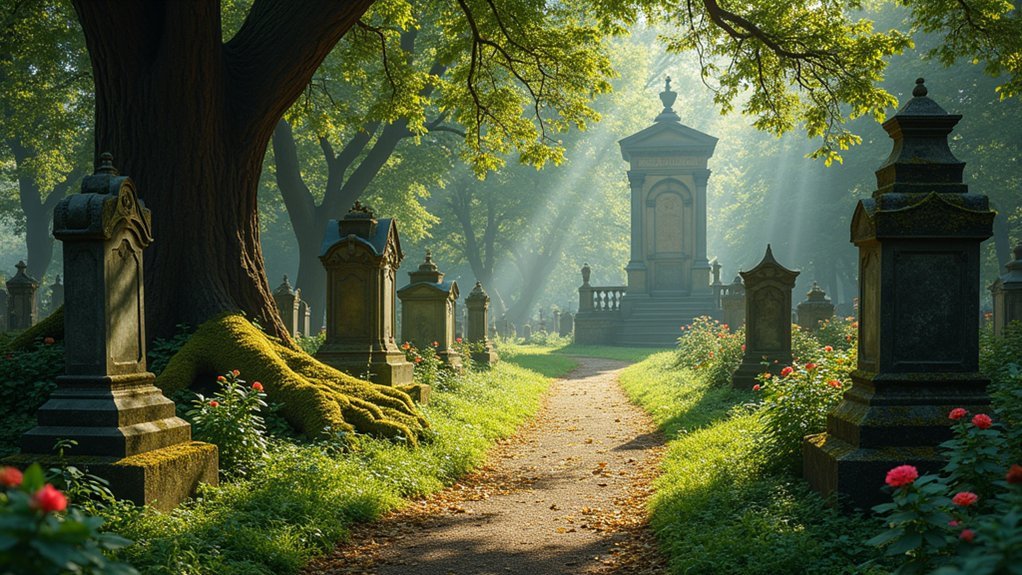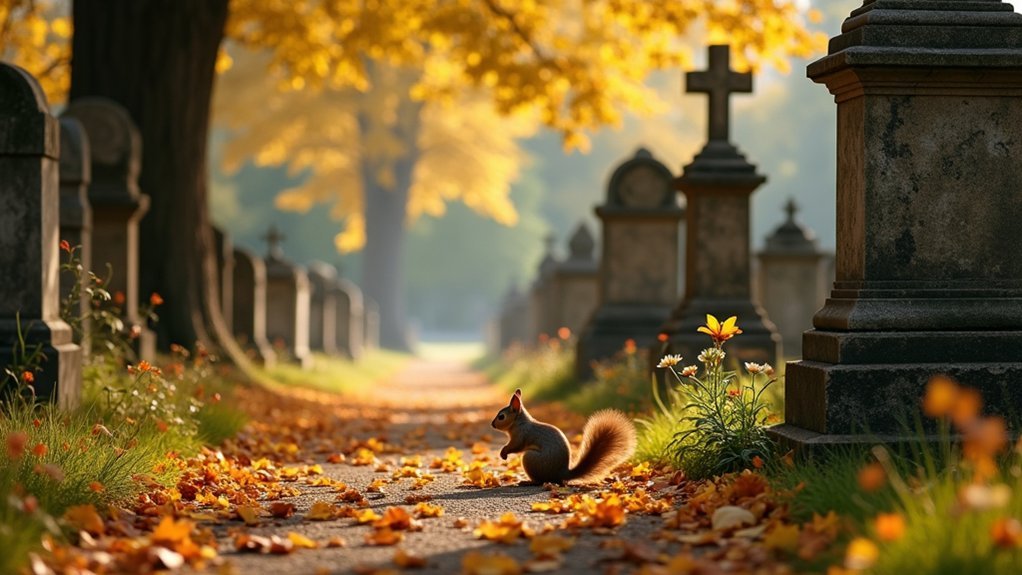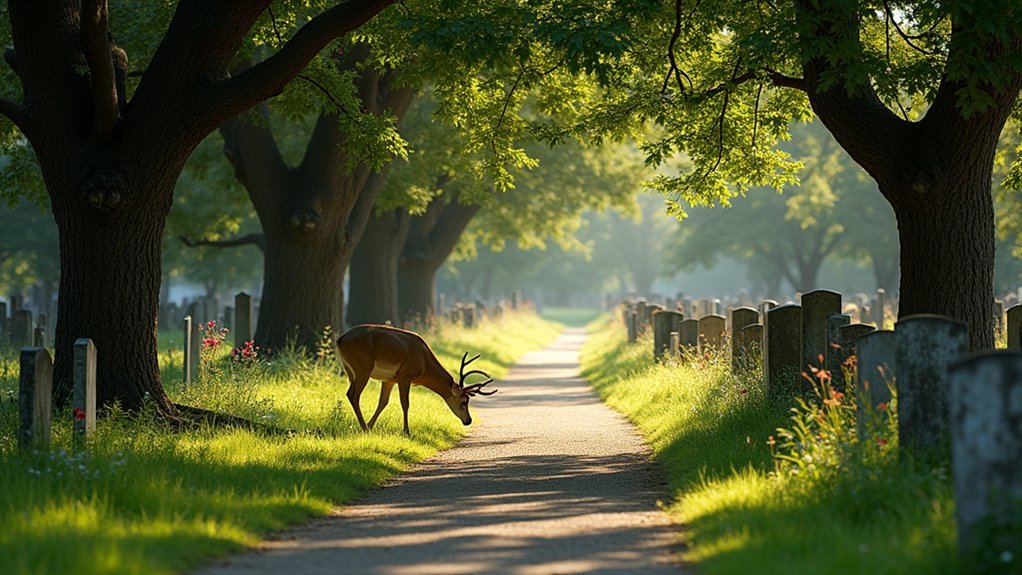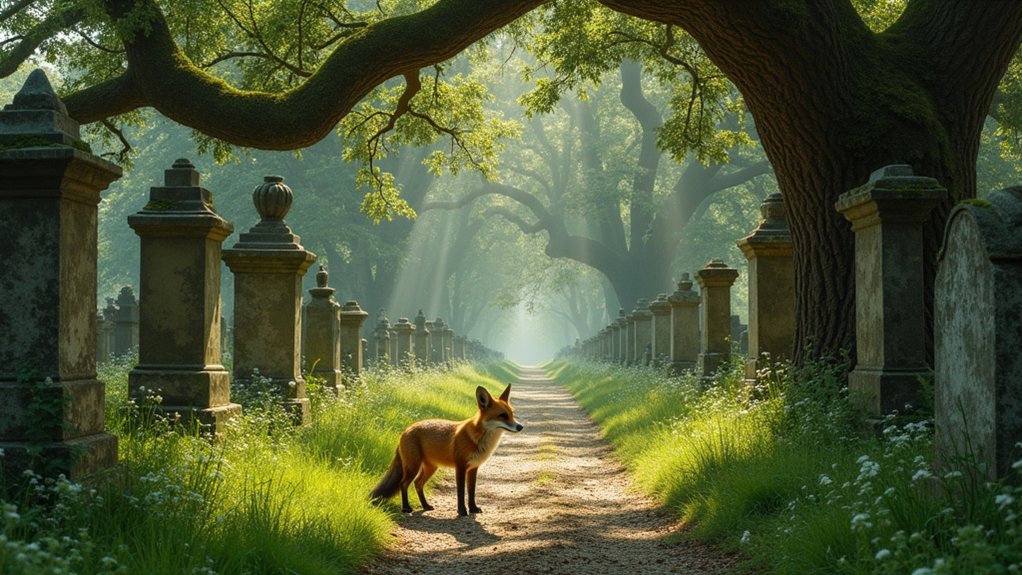Historic cemeteries offer unique trails where you’ll encounter diverse wildlife amid solemn history. You can spot woodpeckers, chickadees, and seasonal visitors like deer seeking shelter among centuries-old headstones. Many cemetery managers now intentionally maintain wilder sections to support ecosystems while preserving heritage. Remember to stay on designated paths, keep quiet, and use binoculars to respectfully observe nature. These peaceful sanctuaries reveal unexpected connections between memorial spaces and thriving biodiversity.
Historic Cemetery Gardens as Urban Wildlife Sanctuaries

While they may seem like solemn resting places for the departed, historic cemetery gardens have emerged as vital wildlife sanctuaries within urban landscapes.
You’ll find these peaceful grounds serving as significant habitats for birds, bees, and small mammals that might otherwise struggle in concrete jungles.
As you walk these grounds, you’ll notice how biodiversity thrives among the headstones. The Audubon Society recognizes many cemeteries as prime bird-watching spots where woodpeckers and mockingbirds find refuge.
Less manicured areas intentionally left by conservation efforts attract deer and raccoons seeking quiet spaces away from city noise.
Your community involvement matters too. Many cemetery managers now deliberately maintain sections in more natural states, creating important havens for declining pollinators and supporting vibrant urban wildlife ecosystems.
Birdwatching Opportunities Among the Headstones
Binoculars and field guides have become familiar tools alongside mourning flowers in historic cemeteries.
You’ll discover that these peaceful burial grounds aren’t just repositories of history but thriving wildlife sanctuaries recognized by the Audubon Society as prime birdwatching locations.
As you wander among the headstones, you’ll encounter:
- Diverse resident species including woodpeckers, mockingbirds, and chickadees filling the air with melodious calls
- Migratory Canadian geese traveling in impressive flocks of up to 100 birds using cemeteries as urban safe havens
- A vibrant ecosystem where pollinators and birds interact around floral resources
This unique convergence of nature and history offers you a contemplative experience, allowing for wildlife observation while reflecting on the stories etched in stone around you.
Seasonal Wildlife Encounters on Cemetery Paths

As the seasons shift across cemetery landscapes, you’ll encounter an ever-changing parade of wildlife that transforms these sacred grounds into dynamic nature preserves.
In winter, you’ll spot deer seeking shelter among gravestones when food becomes scarce elsewhere.
Spring and summer bring heightened squirrel activity, particularly in older cemetery sections where they playfully dart between monuments.
Year-round, cemeteries serve as vital habitats for diverse birds—woodpeckers and sparrows offer excellent birdwatching opportunities regardless of season.
Don’t miss twilight hours when foxes and raccoons emerge, adding to the rich biodiversity.
These peaceful settings have become urban wildlife refuges where nature thrives undisturbed.
Even bees flourish here, with many cemeteries now hosting beekeeping initiatives to support these essential pollinators throughout the seasonal cycles.
Conservation Efforts in Cemetery Ecosystems
The seasonal wildlife activity you’ll witness is supported by thoughtful conservation work happening behind the scenes.
Today’s cemetery managers are actively transforming these spaces into urban wildlife refuges, where natural flora flourishes and ecosystems thrive. You’ll notice older sections deliberately left wilder to support diverse insect populations that form the foundation of local food chains.
- Community involvement programs invite volunteers to document historic gravestones while helping maintain ecological balance.
- Beekeeping initiatives place hives throughout the grounds, producing local honey while supporting essential pollinators.
- GPS technology enables precise burial tracking in conservation cemeteries, ensuring both human remembrance and environmental protection coexist.
These conservation efforts represent a thoughtful evolution in how we view cemeteries—not just as places of remembrance, but as crucial sanctuaries for biodiversity in urban environments.
Ethical Guidelines for Wildlife Observation in Memorial Spaces

Observing wildlife in cemetery spaces requires a thoughtful balance between your curiosity and respect for both the natural inhabitants and the sacred purpose of these grounds.
When exploring these historical sites, always maintain a respectful distance from wildlife to prevent disturbing their natural behaviors and habitats.
Bring binoculars or cameras with zoom lenses to enhance your observation experience while minimizing your impact.
Distance creates connection—binoculars and zoom lenses reveal nature’s details while respecting the sanctity of cemetery wildlife habitats.
Remember to follow cemetery regulations—stay on designated paths and never feed the animals, as this protects both the wildlife and preserves the dignity of the memorial space.
Keep noise to a minimum during your visit. Quiet movement allows you to witness authentic wildlife behavior while honoring the peaceful atmosphere.
Consider joining local conservation initiatives that protect cemetery habitats while preserving their historical significance.
Frequently Asked Questions
Are Night Tours Available to Observe Nocturnal Cemetery Wildlife?
Yes, you can join guided night tours to observe nocturnal cemetery wildlife. They’re typically available during summer months with limited spots. Check the cemetery’s website for scheduling details and necessary reservations.
How Do Cemetery Caretakers Manage Wildlife That Damages Gravestones?
Caretakers use repellents, fencing, and plant barriers to deter wildlife from damaging gravestones. You’ll often see them installing predator decoys, maintaining buffer zones, and applying protective coatings to preserve historic markers.
Can Visitors Contribute to Wildlife Tracking or Census Programs?
You can contribute to wildlife tracking by joining citizen science programs at cemeteries. Download animal tracking apps, report sightings, or participate in seasonal bird counts that cemetery managers often coordinate with conservation groups.
Are There Designated Quiet Zones for Meditation Among Wildlife?
Yes, you’ll find several designated meditation areas along our trails. These quiet zones feature benches nestled among native vegetation where you can sit peacefully, observe wildlife, and reflect undisturbed by other visitors.
Do Cemetery Wildlife Patterns Differ From Surrounding Urban Areas?
You’ll notice cemetery wildlife differs markedly from urban areas. They’re more diverse and abundant due to limited human activity, expansive green spaces, and fewer disturbances. You’ll find more birds, small mammals, and pollinators there.
In Summary
You’ve discovered that cemeteries aren’t just places of remembrance but vibrant ecosystems where history and nature intertwine. As you walk these peaceful paths, you’re witnessing a unique conservation success story. Remember to tread lightly, respect both the departed and the wildlife that calls these grounds home. Your mindful visits help preserve these special sanctuaries for generations of humans and wildlife alike.





Leave a Reply